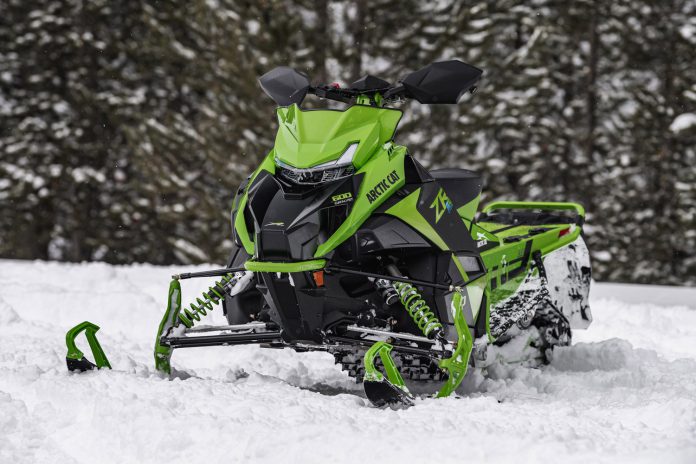This year, new product news has pretty much been consumed with information surrounding the extra-early intro of Arctic Cat’s new CATALYST with 600 C-TEC2 power.
Let’s get this straight before we go on: No one in the snowmobile media has had a pull on the CATALYST with the all-new 858cc Stroker. This means the only reports you can trust that express ride impressions on the CATALYST will be referring to the way, way early introduction of the CATALYST chassis powered by AC’s Dual Stage Injected 600cc twin.
Let’s start this review by exposing a few of the targeted design elements AC employed in the CATALYST. The biggest and we suspect most important design cue is the radical shuffling of the engine to the very depths of the bulkhead while at the same time shoving the motor rearward until it is but millimeters from the tunnel heat exchanger close-off panel.
These two dimensions, foundational to the CATALYST architecture, seem to be at the very center of everything else in its design. Oh, one more thing – Arctic Cat, for the first time in a very long time prioritized and delivered overall weight reduction for the new chassis.
The weight reduction is impressive. Although not officially written down anywhere we can find, we think it safe to say the CATALYST is between 40 and 45 pounds lighter than the Pro-Cross platform. That’s impressive.
So, here’s what a strict and thorough diet, combined with a radically lowered center of gravity (CG) feels like. The new CATALYST with 600 twin power feels like a feather when pitching it into a high-speed sweeper or dragging the brake heavily as you approach a tight, decreasing radius turn. The sled feels really light and exceptionally flickable. One might be inclined to expect inside ski-lift under high G-loads. Nope, doesn’t feel that way at all.
Acceleration with the 125-HP DSI twin underhood is stout. Weight transfer feels okay when exiting corners, however, I would like to see more adjustability in this area to allow for heroic wheelies and sling-shot corner exits. To be clear, as much as we’ve always loved the DSI 600 in the ProCross, planting this renovated mill in the lightweight, low CG CATALYST chassis makes the Dual Stage Injection 600 feel even more formidable and considerably stronger than in the ProCross.
If you doubt my words about the effects of lowering the CATALYST’s CG and how that impacts ride and handling I’ll state – for clarity – just how impressive the new platform is when pushed beyond seven tenths. The sleds handling can legitimately be compared to the telepathic Polaris MATRYX chassis. Is the CATALYST as good as Polaris’ handling champion? Can’t say for sure at this writing not having had the CATALYST and the MATRYX head-to-head. We can tell you for sure the CATALYST sits among some of the best handling sleds in the biz.
More good news comes with the intro of the 858cc SDI twin cylinder engine just revealed. Get this: The 858 was designed and built exclusively for the CATALYST and nothing else. Because of this reality, the 858 sits even lower and further rearward than the 600 DSI. Even better is, the 858 weighs 4 pounds less than the 600!
Handling is obviously affected in a positive way by the low CG and lightness of the CATALYST. However, the long spindle front end design that has been synonymous with Arctic sleds for more than a decade has been shortened up. We like this move from a visual perspective as the shorter spindles allow the CATALYST to appear more “hunkered down”. The important issue is the new front end handles both deep whoops or high speed sweepers equally as well.
The skidframe used in 129 and 137 variants is pretty much a carbon copy of the long-in-the-tooth “Slide Action” skid used in the ProCross. Here’s the deal with this skid: The Slide Action design is targeted at trail chatter allowing the front torque arm to disconnect from the chassis and “float” undamped through stutters.
When craters appear, the rear arm couples up “hard” and resists bottoming. The issue is this: You wouldn’t use the word plush to describe this action. Truthfully, if rMotion had never been invented, the Slide Action Arctic skid would be more than adequate. Reality is this: Many competitive skids suffer by comparison to Ski-Doo’s rMotion.
Finally, Arctic Cat is breaking more new ground with the CATALYST’s’ belt drive. This move contributed significantly to the Cat’s CATALYST weight reduction program. The new belt drive eliminates a heavy (and surprisingly noisy) chain, chain-case, heavy sprockets and chain tensioner. This makes so much sense it is legitimately something that should be copied.
We’ll have more on the new CATALYST soon. If winter descends on us early, we have our new 600 Catalyst PR unit parked with skis facing the door awaiting enough snow to cool the track clips!




